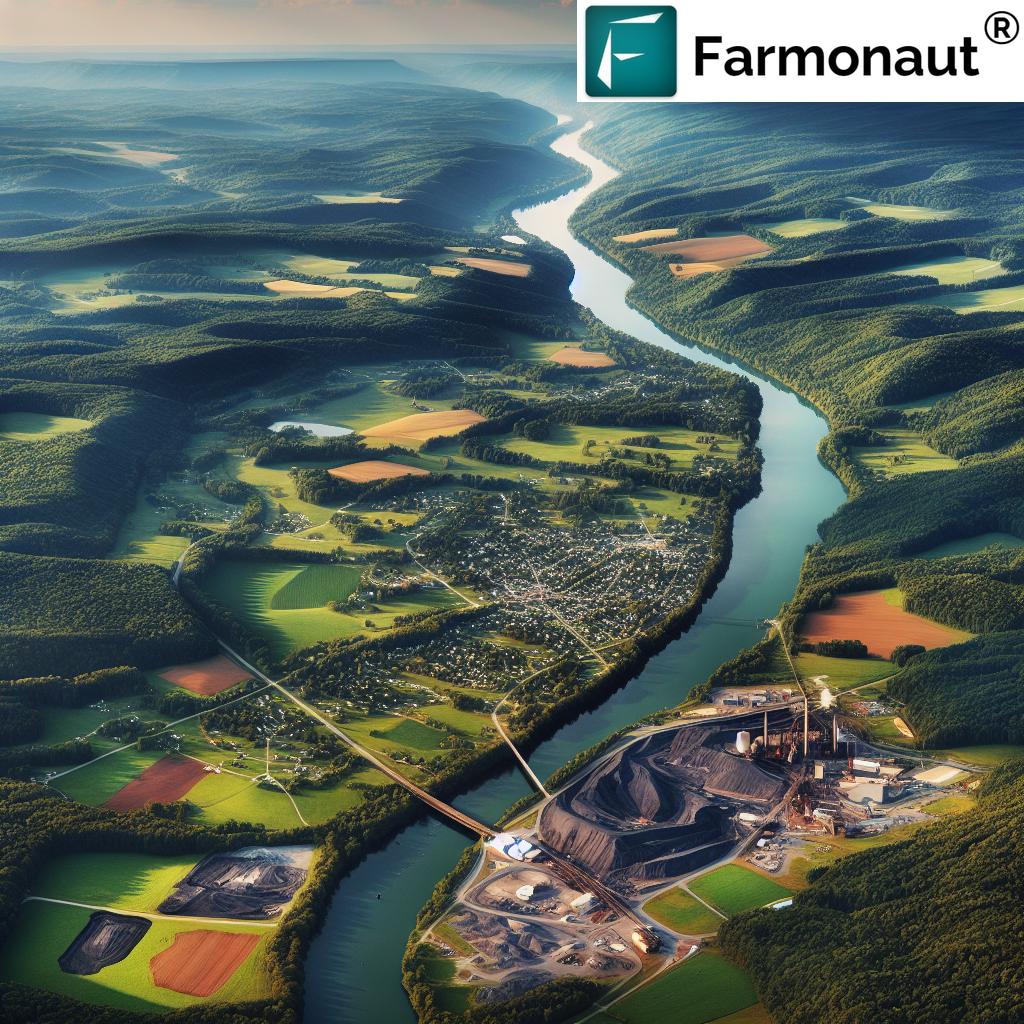From Iron to Innovation: Centre County’s 225-Year Journey of Rural Transformation and Sustainable Growth
“Centre County, Pennsylvania, has transformed over 225 years from iron production to a hub of agriculture, tourism, and business development.”
As we celebrate the 225th birthday of Centre County, Pennsylvania, we embark on a fascinating journey through time, exploring the remarkable transformation of this rural area into a thriving community. From its humble beginnings as a centre for iron production and coal mining to its current status as a hub of agriculture, tourism, and business development, Centre County’s story is one of resilience, adaptation, and sustainable growth.
The Birth of Centre County
On February 13, 1800, Centre County was born from the fusion of parts of Mifflin, Northumberland, Lycoming, and Huntingdon Counties. This strategic consolidation laid the foundation for what would become a unique and prosperous region in the heart of Pennsylvania. The county’s name, “Centre,” was aptly chosen due to its central location within the state, a geographical advantage that would play a crucial role in its future development.

The Era of Iron and Coal
In its early years, Centre County quickly established itself as a powerhouse of iron production and coal mining. The abundant natural resources of the area, including rich iron ore deposits and vast coal seams, fueled rapid industrial growth. The iron furnaces that dotted the landscape became the economic backbone of the region, providing employment and attracting settlers from far and wide.
However, the prosperity of these industries was not destined to last forever. As Mary Sorensen, Executive Director of the Centre County Historical Society, explains, “By 1858, Centre Furnace and other furnaces in the area closed. This was due largely to the panic of 1857, the decline in forest resources, the cost of transporting this iron out of the area and massive deposits of iron that were discovered in the Minnesota Mesabi Iron Range.”
The Decline of Traditional Industries
The closure of the iron furnaces marked a significant turning point in Centre County’s history. The decline of the iron industry, coupled with the gradual reduction in coal mining activities, could have spelled doom for the area. Many rural communities faced with similar challenges have struggled to reinvent themselves, often falling into economic depression. However, Centre County’s story took a different turn, one that would lead to sustainable growth and innovation.
The Rise of Agriculture and Education
As the iron and coal industries waned, agriculture began to take center stage in Centre County’s economy. The fertile soil and favorable climate made the region ideal for crop production and animal husbandry. Farmers in the area adapted to the changing economic landscape, diversifying their crops and embracing new agricultural techniques.
Coinciding with this agricultural shift, a small school was planting its roots that would forever change the face of Centre County: the Agricultural College of Pennsylvania. This institution, which would later become the renowned Pennsylvania State University (Penn State), was established in 1855.
“The establishment of a renowned agricultural college in Centre County played a key role in its rural development and sustainable growth.”
According to Sorensen, the choice of Centre County as the location for this agricultural college was no coincidence. “They chose Centre County for a number of reasons. It was the quality of soil, the land had already been cleared of trees and was in crop production, it has a healthy climate and natural beauty of the landscape,” she explains. These factors not only made Centre County an ideal location for agricultural education but also set the stage for the symbiotic relationship between the college and the local farming community.
The Impact of Penn State on Rural Development
The establishment of Penn State in Centre County had a profound impact on the region’s rural development. As the college grew, it attracted students, faculty, and researchers from across the country and around the world. This influx of talent and knowledge spurred innovation in agriculture and related fields, benefiting local farmers and businesses.
The university’s research initiatives and extension programs played a crucial role in modernizing farming practices in Centre County and beyond. Farmers gained access to the latest agricultural technologies and techniques, leading to increased productivity and sustainability. This partnership between academia and agriculture became a model for rural development, demonstrating how education and research could drive economic growth in non-urban areas.
Embracing Tourism and Natural Beauty
While agriculture and education formed the new pillars of Centre County’s economy, the region’s natural beauty and rich history opened up yet another avenue for growth: tourism. The picturesque landscape that had initially attracted the founders of Penn State began to draw visitors from far and wide.
The county’s rolling hills, lush forests, and scenic waterways provided the perfect backdrop for outdoor recreation. Hiking trails, fishing spots, and camping areas became popular attractions. Historical sites, including restored iron furnaces and coal mining museums, offered visitors a glimpse into the county’s industrial past.
This burgeoning tourism industry not only created new job opportunities but also helped preserve the county’s natural and historical heritage. It demonstrated that economic growth and environmental conservation could go hand in hand, a principle that would become increasingly important in the years to come.
The Evolution of Business Development
As Centre County moved into the 21st century, it continued to diversify its economy. The presence of Penn State attracted technology companies and research facilities, creating a thriving ecosystem of innovation. Small businesses and startups found fertile ground in the county, benefiting from the skilled workforce produced by the university and the high quality of life offered by the region.
Today, Centre County boasts a diverse economic landscape that includes agriculture, education, tourism, technology, and various service industries. This diversification has made the county more resilient to economic fluctuations and has created a sustainable model for rural development.

Centre County’s Industrial Evolution Timeline
| Year/Period | Primary Industry | Economic Impact |
|---|---|---|
| 1800-1850 | Iron Production | Rapid industrial growth, job creation, population increase |
| 1850-1900 | Coal Mining | Continued industrial expansion, infrastructure development |
| 1855 | Establishment of Agricultural College | Foundation for educational and research-driven growth |
| 1900-1950 | Agriculture | Diversification of economy, sustainable rural development |
| 1950-2000 | Education and Research | Innovation hub, attraction of skilled workforce |
| 2000-Present | Tourism and Business Development | Economic diversification, sustainable growth, increased quality of life |
The Role of Technology in Centre County’s Agriculture
As we reflect on Centre County’s journey, it’s important to recognize the role that technology has played in its agricultural transformation. Modern farming practices, supported by cutting-edge technology, have allowed the county’s agricultural sector to thrive in the face of changing economic landscapes.
One such technological innovation that has made a significant impact is satellite-based farm management. Companies like Farmonaut are at the forefront of this agricultural revolution, offering advanced solutions that make precision agriculture accessible and affordable to farmers of all scales.
Farmonaut’s satellite-based crop health monitoring system provides farmers with real-time insights into vegetation health, soil moisture levels, and other critical metrics. This data-driven approach allows farmers to make informed decisions about irrigation, fertilizer usage, and pest management, optimizing crop yields while reducing resource wastage.
For those interested in leveraging these advanced agricultural technologies, Farmonaut offers various access points:
- Web App:

- Android App:

- iOS App:

- API Access: For developers and businesses looking to integrate satellite and weather data into their own systems, Farmonaut offers API access. Detailed documentation can be found in the API Developer Docs.
Sustainable Practices for the Future
As Centre County looks to the future, sustainability remains at the forefront of its development strategy. The county’s journey from iron production to a diverse, technology-driven economy serves as a model for sustainable rural development. By embracing innovation while preserving its natural beauty and agricultural heritage, Centre County has created a blueprint for long-term growth and prosperity.
Technologies like those offered by Farmonaut play a crucial role in this sustainable future. By enabling precision agriculture, these tools help farmers reduce their environmental impact while increasing productivity. Features such as carbon footprint tracking allow agribusinesses to monitor and reduce their emissions, aligning with global efforts to combat climate change.
The Enduring Appeal of Centre County
Despite its remarkable transformation over the past 225 years, Centre County has managed to maintain its unique charm and sense of community. As Mary Sorensen notes, “It still has a sense of isolation. There’s still a sense of it being a small community and not an enormous city.”
This balance between progress and preservation is perhaps the most remarkable aspect of Centre County’s journey. The county has embraced innovation and growth without sacrificing the qualities that make it special – its natural beauty, rich history, and strong sense of community.
Looking to the Future
As Centre County celebrates its 225th birthday, it stands as a testament to the power of adaptation, innovation, and sustainable development. From its roots in iron production to its current status as a hub of education, agriculture, and technology, the county has continually reinvented itself while staying true to its core values.
The future of Centre County looks bright, with continued opportunities for growth in agriculture, education, tourism, and technology. As County Chair Mark Higgins stated, “However you come to know Centre County, you’re almost certain to be bound by its charm.” This enduring appeal, combined with a forward-thinking approach to development, ensures that Centre County will continue to thrive for generations to come.
Embracing Agricultural Innovation
As we look to the future of Centre County’s agricultural sector, it’s clear that embracing technological innovation will be key to continued success and sustainability. Platforms like Farmonaut are leading the way in this agricultural revolution, offering tools that can significantly enhance farm productivity and efficiency.
One of Farmonaut’s standout features is the Jeevn AI Advisory System. This AI-driven tool provides personalized farm advice, delivering real-time insights, weather forecasts, and expert crop management strategies directly to farmers. By analyzing satellite data and other inputs, Jeevn AI generates customized recommendations that can help farmers make more informed decisions about their crops.
For those interested in leveraging these advanced agricultural technologies and contributing to the growth of sustainable farming practices, Farmonaut offers an exciting opportunity through its affiliate program.
Earn With Farmonaut: Affiliate Program
Earn 20% recurring commission with Farmonaut’s affiliate program by sharing your promo code and helping farmers save 10%. Onboard 10 Elite farmers monthly to earn a minimum of $148,000 annually—start now and grow your income!
Farmonaut Subscriptions
Frequently Asked Questions
- What were the main industries in Centre County’s early history?
In its early years, Centre County was primarily known for iron production and coal mining. - When was Centre County founded?
Centre County was founded on February 13, 1800. - What role did Penn State play in Centre County’s development?
The establishment of Penn State (initially the Agricultural College of Pennsylvania) in 1855 played a crucial role in Centre County’s rural development, attracting talent and driving innovation in agriculture and related fields. - How has Centre County’s economy evolved over the years?
Centre County’s economy has evolved from iron and coal production to agriculture, education, tourism, and modern business development, including technology and research sectors. - What factors contributed to the decline of iron production in Centre County?
The decline of iron production was due to the panic of 1857, depletion of forest resources, high transportation costs, and the discovery of massive iron deposits in the Minnesota Mesabi Iron Range.
As we conclude our journey through Centre County’s 225-year history, we’re reminded of the power of resilience, innovation, and community. From its iron-forged beginnings to its current status as a hub of education, agriculture, and technology, Centre County has continuously adapted to changing times while preserving its unique character. The county’s story serves as an inspiration for rural communities worldwide, demonstrating how embracing change and innovation can lead to sustainable growth and prosperity.
Whether you’re a long-time resident, a student at Penn State, or a visitor exploring the county’s natural beauty and rich history, Centre County’s charm is undeniable. As it steps into its 226th year, Centre County continues to look forward, ready to face new challenges and seize new opportunities, all while honoring the legacy of those who came before.
Here’s to Centre County – a shining example of rural transformation and sustainable growth. May its next 225 years be as remarkable as the last!













